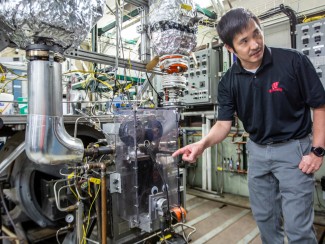
Large-scale data centers — the massive warehouses full of mainframe computers that form the information backbones of companies such as Google, Facebook, Microsoft and Amazon — will soon account for as much as one-fifth of electric power use in the United States.
Surprisingly, those data centers could help ease an important strain on the nation’s power grid by offering a quick and easy strategy to fine-tune regional demand for electricity.
“Flexibility is essential for the grid to withstand extreme events like severe weather or a cyber-attack,” says Victor Zavala, an associate professor of chemical and biological engineering at the University of Wisconsin–Madison.
Researchers from UW–Madison and the University of Chicago will explore the idea that data centers could make the power grid more flexible with a $1.8 million grant from the National Science Foundation.
“If you put the data centers in different strategic locations in the network, they can operate like valves that help you control the flow of power in the network,” says Zavala, who is leading the UW contingent along with electrical and computer engineering professors Bernard Lesieutre and Line Roald.
Excessive electricity that cannot be easily absorbed into one regional grid is a big challenge for the nation’s power markets. Often, one area of the country can have a power surplus while another region might experience rolling blackouts.
“The power grid has limited transmission capacity,” says Zavala. “What power networks need is the ability to distribute loads in space and time.”
In other words, excessive electricity from a Midwest wind farm on a particularly blustery day can’t realistically help alleviate a rolling blackout in California during a heat wave.
Yet that extra electricity needs to go somewhere. When wind turbines or other energy sources produce more electricity than the local cities demand, regional independent system operators must sell that so-called “stranded power” at steep discounts.
In 2014 alone, stranded power in the mid-continent region (which includes Wisconsin and the Midwest) amounted to 17 terawatt hours, or enough to power 1 million homes. As increasing amounts of energy come from renewable sources like wind turbines — which can generate wildly variable amounts of electricity depending on weather conditions — more and more stranded power will need to be absorbed into the grid.
“If you put the data centers in different strategic locations in the network, they can operate like valves that help you control the flow of power in the network.
Victor Zavala
Given that one large-scale data center consumes as much electricity as a small town, it seems logical that locating a data center directly adjacent to a wind farm or a solar array could solve two problems at once: making use of stranded power and keeping computer processors humming.
What Zavala and colleagues have found, however, is that the solution lies within the data centers themselves. Distributing those centers at different locations throughout a power grid, not necessarily directly next to the plants, is better for the electrical network as a whole.
“Data centers have the ability to shift demands across the country almost instantly. That gives you unprecedented geographical flexibility,” says Zavala.
Unlike normal buildings, which need to keep their lights on during specific hours every day depending on their locations, data centers have substantial leeway as to when and where they perform energy-intensive computations.
For example, Facebook could pick and choose among multiple data centers on the east and west coasts, depending on the availability of stranded power in those regions.
Regional power distributors across the United States don’t coordinate with each other in this manner, and that’s one reason why stranded power tends to accumulate between the borders of different independent system operators. That’s why one component of the project is to identify market incentives that could allow data centers to participate more directly.
“These are imperfections in the markets that don’t allow data centers to provide this flexibility,” says Zavala. “So, the question is how do we redesign the markets?”
It’s a question that is taking on urgency as the regional demographics of the United States continue to shift. With more people moving from rural to urban areas, demand for power is becoming concentrated into fewer and fewer smaller regions.
“Flexibility will give you more resilience and enable a more sustainable growth of the power grid,” says Zavala.
Principal investigators at the University of Chicago are Andrew Chien, the William Eckhardt Distinguished Service Professor in the Department of Computer Science, and John Birge, the Erry W. and Carol L. Levin Distinguished Service Professor of Operations Management in the Booth School of Business.
The research is supported by National Science Foundation Award No. 1832230.





